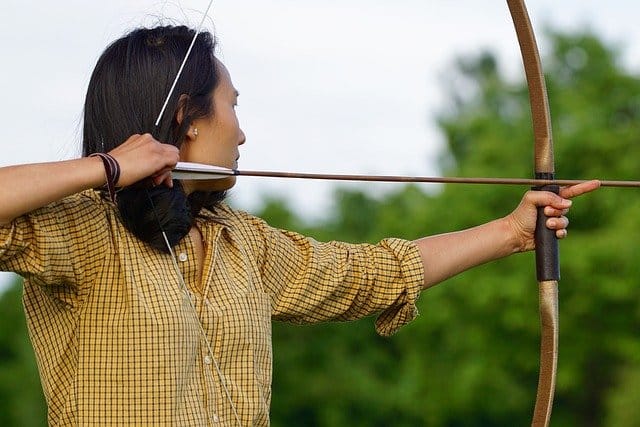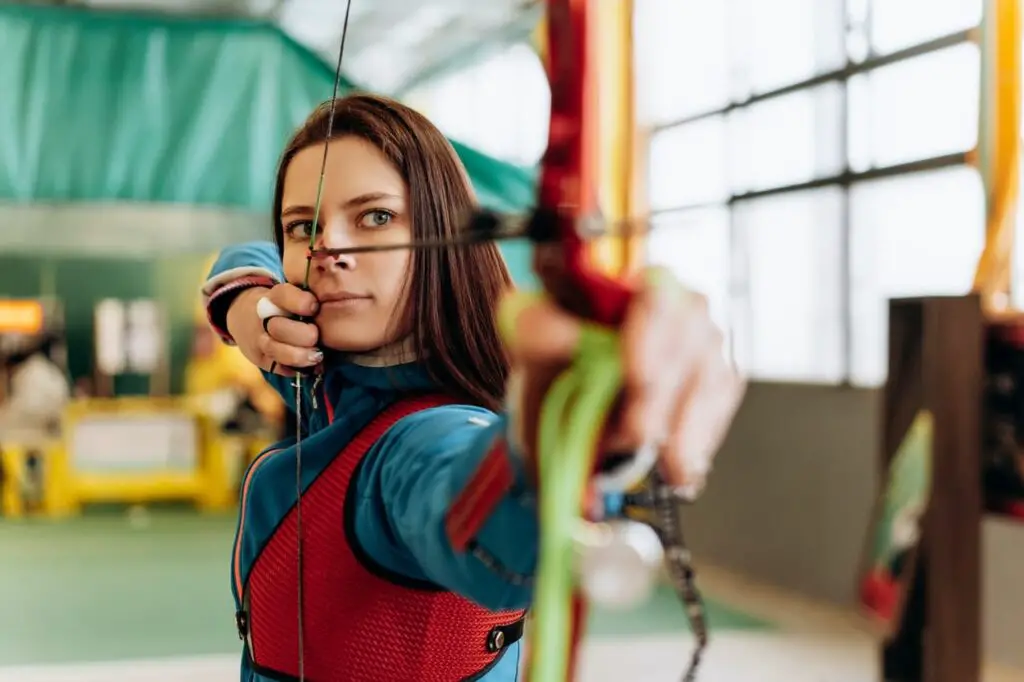A crucial aspect that greatly influences the performance of an archer is arrow speed. The velocity at which an arrow travels can significantly impact its trajectory, penetrating power, and overall effectiveness on the target. Consequently, understanding arrow speed becomes essential for any aspiring archer or enthusiast seeking to optimize their shooting prowess.
The Importance of Arrow Speed in Archery
Arrow speed plays a pivotal role in determining various aspects of a shot’s success in the world of archery. When an arrow is released from the bowstring, it encounters several forces that can affect its flight path: gravity pulls it downward while air resistance exerts opposing pressure.
Therefore, achieving sufficient arrow speed can compensate for gravitational forces and minimize the impact of air resistance on trajectory. Increased arrow speed provides several advantages during target practice or hunting scenarios.
First and foremost, higher velocities reduce the time it takes for an arrow to reach its intended target. This decreases the chance of bumpy winds or sudden movements affecting its path during travel.
Furthermore, greater speeds enhance accuracy by reducing any perceived “archer’s paradox” – where discrepancies between aim and actual flight occur due to inconsistencies caused by factors such as bow torque or hand placement. Faster arrows have less time to deviate from their initial trajectory before reaching their intended mark.
In addition to these benefits related to accuracy and precision, faster arrows also tend to possess superior kinetic energy upon impact with a target. This increased energy transfer leads to deeper penetration into objects such as game animals or dense targets in competitive settings.
Definition of Arrow Speed and Its Measurement
Arrow speed refers to the velocity at which an arrow moves through the air. Typically measured in feet per second (fps), arrow speed acts as a measure of how fast an arrow travels from the moment it leaves the bow until it reaches its intended destination.
Measuring arrow speed accurately is crucial for archers aiming to optimize their shooting performance. One widely used method for measuring arrow speed is through the use of chronographs.
These devices consist of sensors that detect when an arrow passes through their field of view. By capturing this moment accurately, chronographs can calculate the time taken by the arrow to travel a known distance, thereby calculating its velocity.
Another advanced method for measuring arrow speeds involves using Doppler radar systems. These high-tech devices emit radio waves that bounce off moving objects and return to the radar unit, providing precise measurements of velocity.
Doppler radars offer unparalleled accuracy compared to traditional chronographs, making them popular choices among professional archers and researchers who require pinpoint measurements for experimentation or data analysis. Understanding these fundamental concepts regarding the importance of arrow speed in archery and methods for its measurement sets a solid foundation for delving deeper into the complexities and factors that influence this critical aspect of archery performance.
Factors Affecting Arrow Speed
Draw weight and its impact on arrow velocity
One of the primary factors influencing arrow speed is the draw weight of a bow. Draw weight refers to the amount of force required to pull back the bowstring before releasing an arrow. As one might intuitively expect, higher draw weights result in faster arrow speeds.
When more force is applied to draw back the bowstring, it stores more potential energy, which is then transferred to the arrow upon release. This increased energy propels the arrow forward with greater velocity.
For instance, a bow with a draw weight of 50 pounds will produce slower arrows compared to one with a draw weight of 70 pounds. The additional tension in higher draw weights allows for greater acceleration of the arrow.
Examples of different draw weights and their corresponding velocities:
To illustrate this correlation between draw weight and arrow speed, let us consider two bows: one with a moderate 60-pound draw weight and another with an impressive 80-pound draw weight. The former may shoot an arrow at around 280 feet per second (fps), while the latter can propel an arrow at approximately 320 fps. This disparity showcases how even a slight increase in draw weight can lead to noticeable gains in velocity.
Arrow weight and its influence on speed
Apart from draw weight, another crucial factor that dictates arrow speed is its own weight. Lighter arrows tend to travel faster than heavier ones due to their lower inertia or resistance to motion during flight.
When an archer shoots a light-weighted arrow, less force is required from the bowstring to accelerate it rapidly. Consequently, lighter arrows experience less drag as they cut through air molecules during their trajectory, allowing them to maintain higher speeds throughout flight.
Exploration of trade-offs between arrow weight and accuracy:
While lighter arrows boast greater speed, there exists a trade-off between arrow weight and accuracy. Heavier arrows tend to be more stable in flight, as they are less susceptible to external factors such as wind gusts.
Read about how to calculate arrow weight. Or about find out how much your arrow should weigh.
Additionally, heavy arrows often penetrate targets more effectively due to their increased momentum. Therefore, archers must strike a balance between arrow weight and accuracy based on their individual shooting style, target distance, and desired outcome.
Bow efficiency and its role in determining arrow speed
Bow efficiency plays a crucial role in maximizing the transfer of energy from the bow to the arrow upon release. Well-designed bows can optimize this energy transfer by minimizing wasted energy through efficient mechanisms such as limb design, cam systems, or bow materials.
Examples of modern bow technologies that enhance efficiency:
Modern archery technology has introduced innovations that significantly improve bow efficiency. Compound bows with their intricate pulley systems allow archers to hold heavier draw weights at full draw while reducing strain and fatigue during aiming. The cams in compound bows provide a let-off effect where the draw weight diminishes once reaching full draw position, enhancing precision and reducing required effort for maintaining steady aim.
Additionally, advancements in bow materials like carbon fiber have contributed to stronger yet lighter bows that maximize energy output. By understanding how factors like draw weight, arrow weight, and bow efficiency influence arrow speed, archers can make informed choices about equipment selection and shooting techniques to achieve optimal performance on the field or at competitive events.
Measuring Arrow Speeds
An Overview of Common Methods Used to Measure Arrow Velocity
When it comes to measuring arrow speed, archers have several methods at their disposal. One widely used tool is the chronograph, which provides accurate readings by using optical sensors.
Chronographs come in various types, such as those that attach to the bowstring or those that are positioned a few feet in front of the shooter. These devices calculate arrow velocity by measuring the time it takes for an arrow to pass through a specific distance between two sensors.
Chronographs: Functionality, Types, and Accuracy Levels
Chronographs offer archers a convenient way to measure arrow speeds. They operate based on principles of light interruption or reflection.
String-mounted chronographs are popular among archers as they provide real-time feedback on the shot’s velocity by attaching directly to the bowstring. On the other hand, chronographs placed farther downrange are effective for capturing information about an arrow’s speed once it has fully stabilized in flight.
Accuracy levels may vary depending on factors like sensor quality and positioning, but modern chronographs generally provide reliable measurements within a small margin of error (+/- 1-2 fps). Archers should ensure proper alignment and calibration for precise readings.
Doppler Radar Systems: Advantages for Precise Measurements
Another advanced method of measuring arrow speed involves Doppler radar systems. Unlike chronographs that rely on direct contact with arrows, these systems utilize radio waves to measure velocity remotely. Doppler radars offer numerous advantages over traditional methods as they can capture multiple data points during an arrow’s entire flight path.
These systems provide highly accurate measurements even at longer distances due to their ability to track moving objects continuously. Doppler radar eliminates any concerns about accuracy discrepancies due to varying distances between targets and sensors.
Units Used to Express Arrow Speeds: Feet Per Second (fps)
The standard unit for expressing arrow speeds is feet per second (fps). This unit measures the distance an arrow travels in one second. Archers and manufacturers commonly use fps as it provides a straightforward and universally understood measurement.
Feet per second allows for easy comparison of different arrows and bows, allowing archers to select equipment that aligns with their desired speed requirements. It also aids in determining arrow trajectory, kinetic energy, and potential accuracy at different distances.


